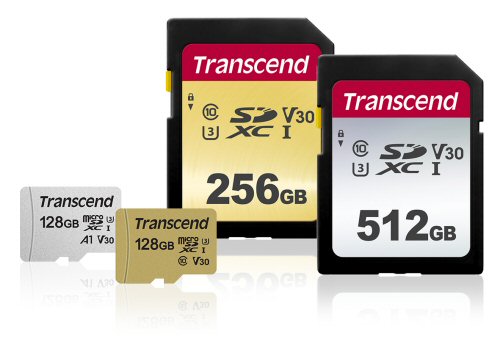- Details
- Flash Memory
Transcend Information, Inc. (Transcend), a leading manufacturer of storage and multimedia products, announced today the release of the 500S and 300S series of SD and microSD cards. These memory cards, produced in capacities of up to 512GB and featuring transfer speeds of up to 95 MB/s, are a ready-made solution for the storage needs of today’s users. The gold 500S series, constructed of durable MLC flash, is ideal for action cameras and drones, while the silver 300S series SD cards are offered in capacities up to 512GB, and the microSD cards have been crafted with the smartphone market in mind.
Meeting A1 performance specifications
Transcend’s 128GB 300S microSD cards meet the SD Association’s latest Application Performance Class 1 (A1) standards for responsiveness, which call for performing 1,500 IOPS on random read operations and 500 IOPS on random write operations, and sequential speeds of at least 10 MB/s. The 300S series tops out at 95 MB/s read and 45 MB/s write speeds, making it ideal for storing and running mobile apps.
- Details
- Flash Memory
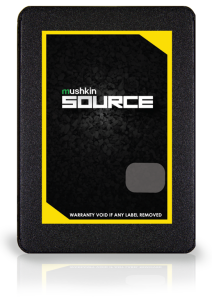 Mushkin Enhanced MFG, an industry-leading designer and manufacturer of high-performance computer products, is announcing the Mushkin Source Series, a new line of solid state drives (SSDs) for the retail, e-tail, system integrator, and channel markets. The Source Series features a powerful, yet cost-effective design suitable for a wide-range of applications.
Mushkin Enhanced MFG, an industry-leading designer and manufacturer of high-performance computer products, is announcing the Mushkin Source Series, a new line of solid state drives (SSDs) for the retail, e-tail, system integrator, and channel markets. The Source Series features a powerful, yet cost-effective design suitable for a wide-range of applications.
“The market has never been more ready for SSDs,” says Brian Flood, Director of Product Development for Mushkin Enhanced MFG. “With the ultimate balance of value, capacity, and performance, the Source Series leverages all of the great benefits expected from an SSD without breaking the bank.”
Source SSDs are ideal for mainstream computing – from gaming desktops and notebooks to mini-PCs (NUCs) and everything in between. Offered in 2.5” and M.2 2280 form factors, the Source Series is an excellent choice for almost any system. Source SSDs are available in 120GB, 250GB, 500GB and 1TB capacities and can achieve max sequential performance of up to 560MB/s read and 520MB/s write. Each Source SSD is protected by M.E.D.S. (Mushkin Enhanced Data-protection Suite) ensuring valuable data is protected and is backed by a 3-year warranty to ensure peace of mind.
Add a comment- Details
- Flash Memory
ADATA Technology, a leading manufacturer of high performance DRAM modules and NAND Flash products, today launched the XPG SX8200, its fastest consumer SSD to date. It arrives in a compact M.2 2280 form factor and uses the ultra-fast PCIe3x4 interface to deliver up to 3200MB/s read and 1700MB/s write – which is perfect for gamers, overclockers, and PC DIY enthusiasts in pursuit of unsurpassed performance! SX8200 employs the latest 2nd generation 64-layer 3D NAND Flash for improved reliability and ships in capacities of 240GB, 480GB, and 960GB.
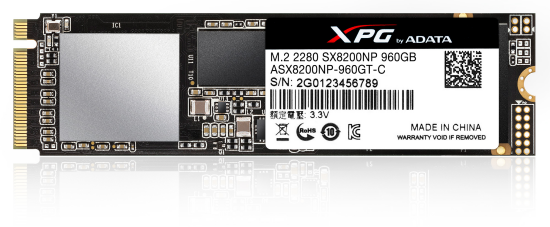
PCIe Gen3x4 - Breakthrough the Barrier of Speed
Leveraging ultra-fast PCIe Gen3x4 interface and the NVMe 1.3 protocol, the SX8200 provides tremendous improvement in read/write performance. It implements a 32bit DRAM data bus, intelligent SLC Caching, and a DRAM cache buffer, accelerating sequential and 4K random read/write speeds. It reaches speeds of up to 3200MB/s for reads and 1700MB/s for writes and 310K/280K IOPS random 4K read/writes for faster boot, shorter game loads, and system response time.
- Details
- Network Storage
Synology Inc. today announced the general availability of the Synology C2 Backup service to users worldwide. Initially established to meet the increasing demands from European customers for a secure and highly-integrated cloud backup solution, C2 Backup now allows precious data stored on Synology NAS around the world to retain copies on Synology's own cloud storage service in case of disaster recovery.

C2 Backup has experienced tremendous growth in its first six months following its initial launch in Europe. The 96% subscription retention rate after the 30-day free trial has caused Synology to expand its Frankfurt based data center and offer the service to users outside the EMEA region. All the success in the European market proves the service to be a well-optimized and cost-effective solution, that will now benefit even more customers worldwide.
Add a comment- Details
- Flash Memory
Marvell, a leader in storage, networking and connectivity semiconductor solutions, today announced that it is launching innovative NVM Express (NVMe)-based chipset solutions that will accelerate the time to market for application-optimized data center SSD implementations. These new, highly-versatile building blocks can optimally address current and emerging workload storage requirements, spanning capacity, latency, performance, power and cost, to enable tailored SSD solutions for specific cloud and enterprise workloads.

The proliferation of cloud services and new technologies, such as artificial intelligence and machine learning, is driving various workloads in the data center. These evolving and expanding workloads can have differing storage requirements that emerging SSD form factors are targeted to address. Marvell has developed innovative NVMe chipsets capable of powering the larger Enterprise Data Storage Form Factors (EDSFF), Next Generation Small Form Factors (NGSFF) and various customized form factors, providing the ability to increase storage capacity, performance and overall workload efficiencies.
Add a comment- Details
- Flash Memory
 LITE-ON Storage, an established leader in the rapidly expanding solid-state drive (SSD) industry, said today it will demonstrate its latest enterprise drives, the NVRAM Hybrid SSD, during the OCP U.S. Summit 2018, kicking off here today.
LITE-ON Storage, an established leader in the rapidly expanding solid-state drive (SSD) industry, said today it will demonstrate its latest enterprise drives, the NVRAM Hybrid SSD, during the OCP U.S. Summit 2018, kicking off here today.
The new LITE-ON NVRAM Hybrid drive, slated for release this spring, is a compact high-density drive with multi-namespaces. One of the namespaces can be dedicated to NVRAM drive and the other namespace to boot drive, fully utilizing the NAND portion of the drive. This drive has a dual-use feature such that it can serve as boot drive for server with the SSD namespace and as cache with the NVRAM part of the drive, resulting in reduced overall Total Cost of Ownership (TCO) with a better utilization rate.
“Customers tell us they need the most technologically advanced SSDs in their enterprises, but those storage solutions must also make financial sense,” said Darlo Perez, Managing Director, LITE-ON Storage Group. “Our new NVRAM Hybrid SSD is capable of meeting today’s demanding and time-sensitive data center requirements while maximizing TCO.”
Add a comment- Details
- Flash Memory
 Samsung Electronics Co., Ltd., the world leader in advanced memory technology, today announced that it is rolling out its PM883, the highest density datacenter SATA drive, at eight terabytes (TB). Samsung’s new solid state drive (SSD) offering is the industry’s first datacenter SATA drive to incorporate LPDDR4 DRAM modules and features a 6.0-gigabits-per-second (Gbps) 2.5-inch SATA interface.
Samsung Electronics Co., Ltd., the world leader in advanced memory technology, today announced that it is rolling out its PM883, the highest density datacenter SATA drive, at eight terabytes (TB). Samsung’s new solid state drive (SSD) offering is the industry’s first datacenter SATA drive to incorporate LPDDR4 DRAM modules and features a 6.0-gigabits-per-second (Gbps) 2.5-inch SATA interface.
The high-performance PM883 is expected to accelerate a transition in many existing enterprise datacenters to SATA-formatted SSD designs, with improved economies of scale through the use of advanced-generation V-NAND technology at higher densities.
“We are thrilled to have the opportunity to enable a high level of storage density with low power consumption, which thanks to the efficiency of our 64-layer V-NAND-based technology, allows us to double the capacity of current SATA storage,” said Jim Elliott, corporate senior vice president, memory sales and marketing, Samsung Semiconductor, Inc. “Our expanded lineup for the PM883 will offer up to 8TB to allow optimal use in existing enterprise and cloud storage systems.”
Add a comment- Details
- Hard Disks
 Seagate Technology plc, a world leader in data storage solutions, today unveiled its 14TB helium-based Exos X14 enterprise drive at the OCP U.S. Summit 2018 in San Jose, Calif. The Seagate Exos X14 delivers high performance and greater capacity for hyperscale data centers looking to efficiently and cost-effectively manage increasing amounts of data.
Seagate Technology plc, a world leader in data storage solutions, today unveiled its 14TB helium-based Exos X14 enterprise drive at the OCP U.S. Summit 2018 in San Jose, Calif. The Seagate Exos X14 delivers high performance and greater capacity for hyperscale data centers looking to efficiently and cost-effectively manage increasing amounts of data.
Enterprises across the globe face the daunting challenge of managing a massive increase in data volume as the world is expected to create 163 zettabytes of data in 2025, according to a study by analyst firm IDC and sponsored by Seagate. As the need for hyperscale and cloud storage rises to unprecedented levels, Seagate’s Exos X14 hard drive is a direct response to customer demand for increased enterprise storage capacity and efficiency.
By offering greater storage density in the same 3.5-inch footprint, Seagate’s Exos X14 drive is ideal for hyperscale environments. Enhanced areal density means Seagate can deliver higher capacity storage in a smaller package—a milestone for meeting the demand of increasing data center needs. The Exos X14 offers the industry’s lowest power consumption, smallest footprint, and best performance in its class, making the hard drive an affordable solution for data centers looking to maximize their storage capabilities while reducing complexity and operational costs.
Add a comment- Details
- Network Storage
QNAP Systems, Inc. today launched the cost-effective high-performance 4-bay (TS-473), 6-bay (TS-673), and 8-bay (TS-873) TS-x73 series NAS featuring an AMD RX-421ND quad-core CPU with Turbo Core up to 3.4GHz and two PCIe slots for installing a QNAP QM2 card, wireless network card or a graphics card to extend NAS functionalities. The TS-x73 series provides small and medium businesses with an ideal NAS solution to build a private cloud for applications including high-speed data transfer, backup/recovery, virtualization, media playback and graphics display.
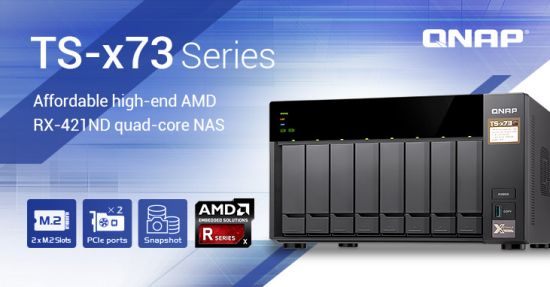
“The TS-x73 NAS series presents a budget-friendly solution by allowing users to add more value to their NAS based on their individual needs. Through the two PCIe slots, users can install a QNAP QM2 card to add SSD caching/10GbE connectivity for boosted performance; a wireless card with WirelessAP Station app to turn the NAS into a wireless access point; or even an PCIe bus-powered graphics card to enable 4K transcoding and HDMI output for a greater media multimedia experience,” said Jason Hsu, Product Manager of QNAP.
Add a comment- Details
- Flash Memory
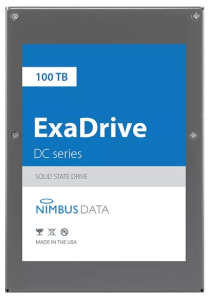 Nimbus Data, a pioneer in flash memory solutions, today announced the ExaDrive DC100, the largest capacity (100 terabytes) solid state drive (SSD) ever produced. Featuring more than 3x the capacity of the closest competitor, the ExaDrive DC100 also draws 85% less power per terabyte (TB). These innovations reduce total cost of ownership per terabyte by 42% compared to competing enterprise SSDs, helping accelerate flash memory adoption in both cloud infrastructure and edge computing.
Nimbus Data, a pioneer in flash memory solutions, today announced the ExaDrive DC100, the largest capacity (100 terabytes) solid state drive (SSD) ever produced. Featuring more than 3x the capacity of the closest competitor, the ExaDrive DC100 also draws 85% less power per terabyte (TB). These innovations reduce total cost of ownership per terabyte by 42% compared to competing enterprise SSDs, helping accelerate flash memory adoption in both cloud infrastructure and edge computing.
“As flash memory prices decline, capacity, energy efficiency, and density will become the critical drivers of cost reduction and competitive advantage,” stated Thomas Isakovich, CEO and founder of Nimbus Data. “The ExaDrive DC100 meets these challenges for both data center and edge applications, offering unmatched capacity in an ultra-low power design.”
Optimized to Maximize Flash Storage Capacity and Efficiency
While existing SSDs focus on speed, the DC100 is optimized for capacity and efficiency. With its patent-pending multiprocessor architecture, the DC100 supports much greater capacity than monolithic flash controllers. Using 3D NAND, the DC100 provides enough flash capacity to store 20 million songs, 20,000 HD movies, or 2,000 iPhones worth of data in a device small enough to fit in your back pocket. For data centers, a single rack of DC100 SSDs can achieve over 100 petabytes of raw capacity. Data centers can reduce power, cooling, and rack space costs by 85% per terabyte, enabling more workloads to move to flash at the lowest possible total cost of ownership.
Add a comment

